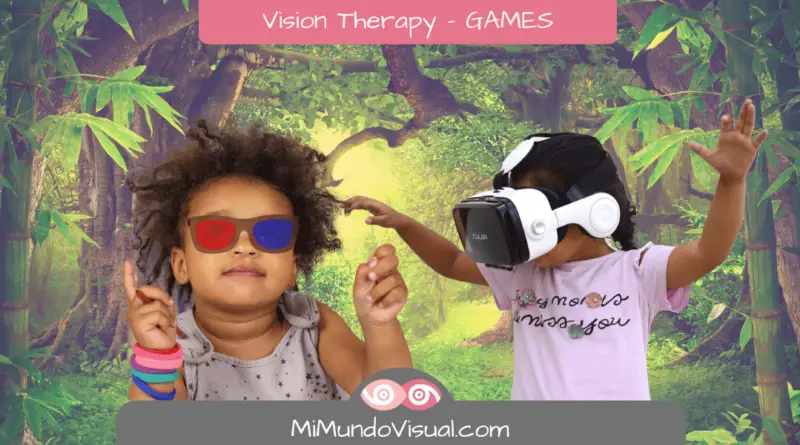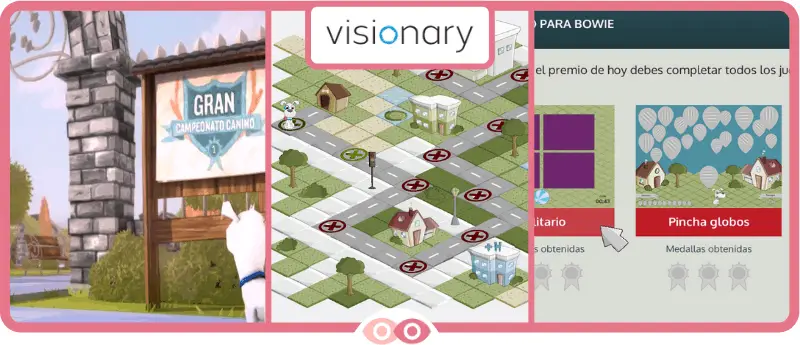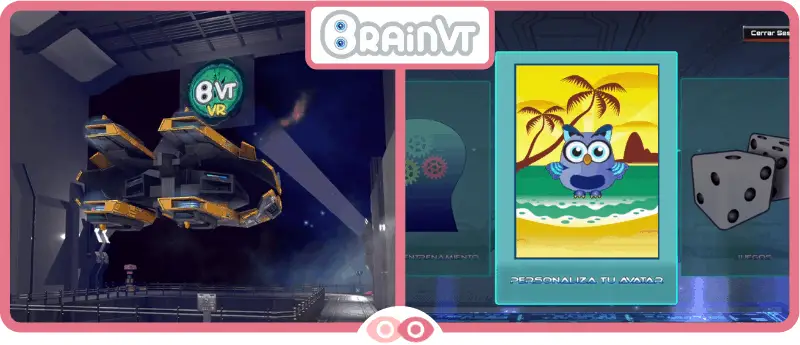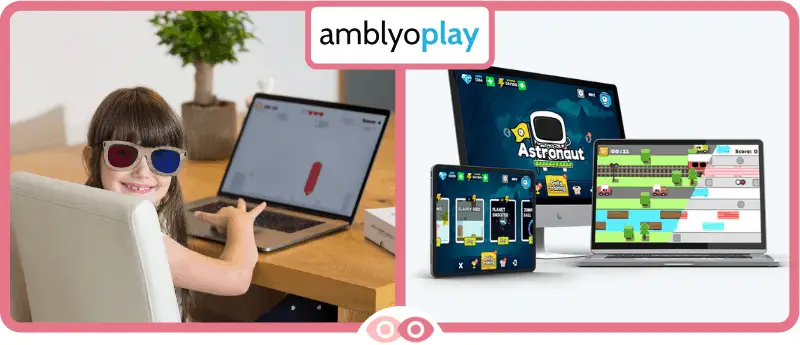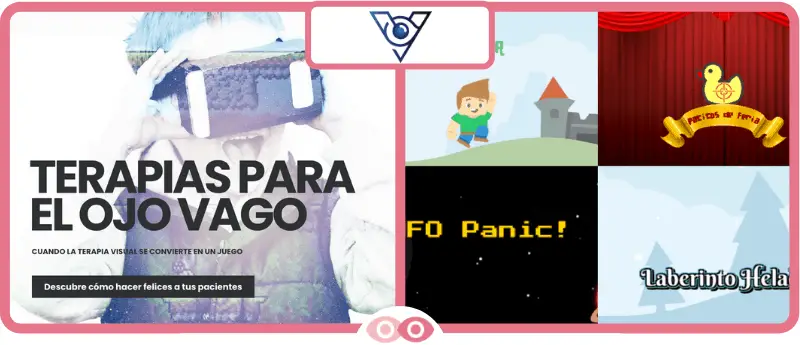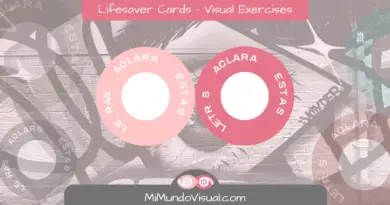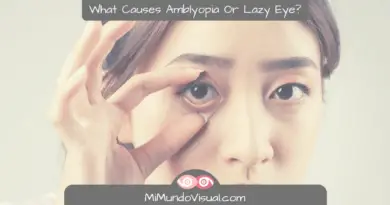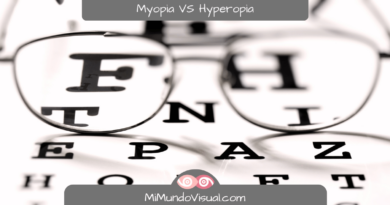5 Vision Therapy Programs (Games) For Treating Amblyopia At Home
Table Of Contents
5 Vision Therapy Programs (Games) For Treating Amblyopia At Home
Today we would like to present 5 examples of programs or games based on new technologies currently used to treat Amblyopia (or Lazy Eye) as part of vision therapy at home.
But before we dive into each, we’ll share more about why new technologies can effectively treat visual impairments such as Amblyopia or strabismus.
Vision Therapy: Video Games and Virtual Reality
- AmblyoPlay – Game Therapy
- VisionaryTool – Game Therapy
- Virtual Reality and Games For Amblyopia Treatment At home!
Download Our Guide About Amblyopia!
New Technologies for Home Vision Therapy
New technologies have made it possible to treat vision problems in entirely new ways. In particular, advances in visual technologies, like games and virtual reality glasses, have created many new options in Optometry and Vision Therapy.
Thanks to the fact that we can use these new technologies, it also allows us to perform more activities at home, which previously could only be done in the doctor’s office.
Since the programs are adapted to the computer or virtual reality glasses, they are ideal for vision therapy to continue at home, under close supervision by the optometrist.
Vision Therapy at Home
This new way of applying vision therapy could be considered a real revolution in treating different visual dysfunctions, such as Amblyopia (Lazy Eye ) or strabismus (crossed eyes).
In 2017, SIODEC (International Society for Developmental and Behavioral Optometry) indicated in a press release how: ‘new technologies applied to vision rehabilitation can recover the ability to see in 3D up to 70%’ after the study conducted by optometrist Juan Portela: ‘Perceptual learning in stereo-deficient subjects with a history of amblyopia.’
What Is The Traditional Way To Treat Lazy Eye At Home?
Traditionally, Amblyopia has been treated at home with occlusion therapy. Occlusion Therapy requires either covering the dominant Eye with an eye patch or penalizing it through specialized eye drops, which cause a blurred image for this Eye so that the amblyopic Eye is forced to work. The goal is to gain visual acuity in the lazy Eye.
However, most amblyopes need to improve stereopsis with this method, as occlusion Therapy alone does not account for training the brain to enhance stereopsis. For this reason, changes are recently being made in how Amblyopia is treated and how to understand it.
In recent decades, many optometrists have begun to understand the importance of treating the entire visual system and not just focusing on visual acuity.
As the NeuroTracker website states: ‘Visual acuity is only 1 out of 17 visual skills needed for an efficient and accurate visual system’.
Having 20/20 Vision does not equal having good Vision
It’s not enough to get a person to have a 20/20 vision; it goes beyond that…
With this idea in mind, programs have been created emphasizing working on stereoscopic vision and depth perception through interactive games.
One of the fundamentals of the success of visual therapy is the motivation that the person has when performing daily visual exercises.
And visual therapy games on a computer or with the help of virtual reality glasses are the perfect complement to make us feel motivated at home to continue with Vision Therapy.
This differs from other types of visual exercises in vision therapy for children and vision therapy for adults, which are not always as novel and exciting as playing a video game.
So, let’s learn a little more about each of these ‘games’ that are being used to treat Lazy Eye:
More about amblyopia in children
- 7 Tips On How To Be Successful With Amblyopia Therapy For Your Child
- How To Remove An Eye Patch Without Pain?
- 6 Eye Patch Therapy Inconveniences We Are Not Told About
- How To Choose The Best Eye Patch For My Child?
- Contact Lenses For Children With Lazy Eye?
- Prepare For Your Visit With the Eye Doctor?
Download Free Amblyopia Guide

Visionary is a tool used in vision therapy to work on visual system problems such as Amblyopia, strabismus, visual problems, etc., adapting to the needs of each person.
With Visionary, we can work on dichoptic visual acuity and binocular Vision and improve stereopsis.
The Visionary software has the following tools:
- Visionary Tool that works with anaglyph or polarized glasses, both in the office and at home, utilizing an access code that our optometrist has to provide us.
- Visionary Eye, which uses eye movements instead of the computer mouse.
- Visionary VR requires virtual reality glasses and can only be performed in the doctor’s office.
To learn more about a Visionary Tool session, read this short review: VisionaryTool, Vision Therapy, and Amblyopia.
#2 At-Home Vision Therapy Kit: BrainVT

BrainVT is a multidisciplinary online platform for integrated visual training that allows working on different visual-brain skills through games.
This Tool is designed to be used both in the office and at home and is designed to work with children, adults, people with special needs, or athletes.
The main visual skills that can be treated with BrainVT are memory, sequence and visual, coordination, hand-eye, eye movements (tracking and saccadic), laterality, shape constancy, anti-suppression, accommodation, peripheral Vision, and 3D fusion, among others.
BrainVT works on a computer, tablet, touch screen, or virtual reality glasses.
#3 At Home Vision Therapy Game: AmblyoPlay

AmblyoPlay is a computer-based tool for vision therapy and utilizing games to make the objective fun and interactive. It aims to train visual difficulties such as Lazy Eye, strabismus, and convergence insufficiency.
Through different games, the visual system is trained, paying particular attention to the weaker Eye and the cooperation between the two eyes and the brain.
The AmblyoPlay sessions can be done in the monocular therapy version, that is, with only one Eye (the weaker or amblyopic Eye), covering the dominant Eye with a patch, or in the binocular therapy version, with anaglyph glasses (red-blue) that are included with the purchase of the pack.
Unlike the other programs discussed in this article, AmblyoPlay can be purchased directly from them without the need for the intermediation of an optometrist to monitor and control our therapy through your computer. Although you can always share the keys with him to keep track of the process.
If you want to know more about AmblyoPlay, you can continue reading: AmblyoPlay Review – Vision Therapy Exercises At Home
#4 Home Vision Therapy Game: Dicopt
Dicopt is a virtual reality dichoptic game app. The Dicopt app is easily installed on a smartphone.
We need the phone to insert into a virtual reality viewer to perform the visual exercises. In addition, the program comes with a Bluetooth controller to control the games.
The Dicopt application, once installed on the cell phone, has 4 games to work daily on Amblyopia in sessions of 10-15 minutes.
This Tool has to be supervised and controlled by our optometrist or ophthalmologist. Still, it is designed to be done at home as a therapy for Amblyopia or Lazy Eye with the cell phone.
However, this Spanish startup may have a health license in the future that will allow them to market their product to patients, as V-Vision’s CEO, Rafael Izquierdo, tells us in this interview.
#5 At-Home Vision Therapy Game: Vivid Vision
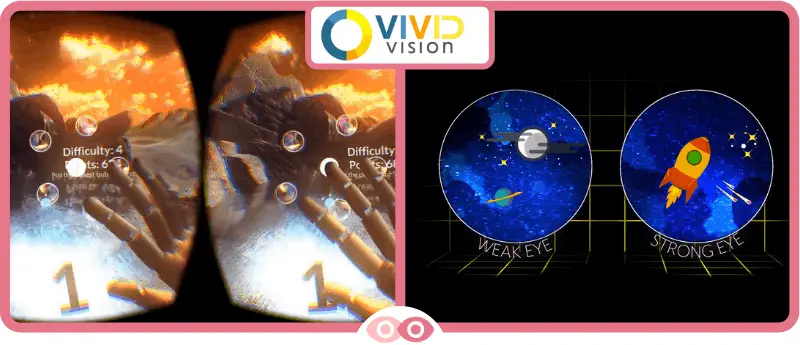
Vivid Vision is a tool that uses virtual reality hardware to treat lazy Eye (Amblyopia), strabismus, and vergence disorders by training binocular Vision and suppression.
It can be used by both children and adults in the clinic (Vivid Vision Clinical) and at home (Vivid Vision Home), always under the supervision of an ophthalmologist or optometrist who will evaluate the best option in our particular case.
The Vivid Vision program offers 9 activities that work on 5 different visual skills:
anti suppression (both eyes work equally, ensuring a complete vision of the environment),
stereopsis (3-dimensional Vision),
visual perceptual processing (discrimination of shape, detail, differences, and synthesis of information),
vergence (near/far movements to make rapid changes),
oculomotor (large, precise, controlled, and fast movements).
What Do New Technologies And Visual Therapy Games At Home Matter?
As we can see, these tools provide the following:
- Games that motivate us.
- Greater performance and involvement.
- Helping us teach the visual system to coordinate and work together.
They are a significant contribution to our visual therapy routine. Still, we must remember that they are only a part of Vision Therapy. They may need to be combined with other visual exercises and more passive treatments like occlusion therapy.
Everything will depend on the case individually, which is why it is so important to go to a vision specialist to evaluate our particular case or that of our family so that they can tell us which is the best option at each moment of the Vision Therapy treatment.
More About Amblyopia or Lazy Eye
- How Do I Know If I Have A Lazy Eye?
- What Causes Amblyopia Or Lazy Eye?
- How To Detect A Lazy Eye?
- What is Amblyopia?
- 6 Eye Patch Therapy Inconveniences We Are Not Told About
- How To Choose The Best Eye Patch For My Child?
- Contact Lenses For Children With Lazy Eye!
- 5 Questions About Lazy Eye In Adults!
- Lazy Eye In Adults – Little Everyday Difficulties That May Be Due To Amblyopia!

